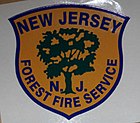 | |
| Operational area | |
|---|---|
| Country | |
| State | |
| Agency overview | |
| Established | 4 July 1906 |
| Annual calls | 1,063 FY2014 |
| Employees | 70 (full-time) approx. 2,000 (part-time) |
| Annual budget | $8,775,000 FY2014 |
| Fire chief | William J. Donnelly (State Firewarden) |
| Facilities and equipment | |
| Divisions | 3 |
| Stations | 21 Fire Towers |
| Tenders | 12 |
| Wildland | 109 |
| Bulldozers | 23 |
| Airplanes | 3 |
| Helicopters | 6 |
| Website | |
| Official website | |
The New Jersey Forest Fire Service (NJFFS) is an agency within the New Jersey Department of Environmental Protection. Founded in 1906 with a focus on wildland fire suppression and fire protection, the Forest Fire Service is the largest firefighting department within the state of New Jersey in the United States with 85 full-time professional firefighting personnel (career civil service positions), and approximately 2,000 trained part-time on-call wildland firefighters throughout the state. Its mission is to protect "life and property, as well as the state's natural resources, from wildfire".[1]
The New Jersey Forest Fire Service covers a primary response area of approximately 3.72 million acres comprising 77% of the state's land area and administered by three regional divisions.[2] These divisions are divided into 29 sections, and further into 269 districts overseen by Section firewardens. All Firewardens are sworn law enforcement officers with authority pursuant to state law. These powers include broad authority to compel actions for fire prevention, to investigate a wildfire's cause (accidental or intentional), and exercise arrest and citation powers in matters involving criminal and civil liability. Firewardens are qualified incident commanders and direct operations of fire crews in suppression efforts. This primary response area includes the state's rural and suburban areas, as well as its public state parks and forests.
Because of the extent of suburban development in New Jersey, many of the state's residents live within a transition zone known as the wildland-urban interface which provides both increased challenges to fire suppression tactics and increased risk of fires causing damage to homes and property. In 2014, the New Jersey Forest Fire Service responded to 1,063 wildfire events that damaged 6,692 acres of wildlands. As a preventative measure, the service conducted controlled burns or prescribed burns on 15,326 acres statewide.[3]
- ^ New Jersey Forest Fire Service, "About Us" and "Our Organization". Retrieved 19 April 2015.
- ^ New Jersey Forest Fire Service. Administrative Boundaries (map). Retrieved 18 April 2015. Note: While the map delineates 3.72 million acres as the primary response area, other New Jersey Forest Fire Service publications list figures indicating a responsibility over 3.1 million or 3.2 million acres.
- ^ Office of Management and Budget (New Jersey Department of the Treasury), "Department and Branch Recommendations: Environmental Protection" in State of New Jersey: The Governor's FY2016 Detailed Budget (2015), D-113 through D-115. Retrieved August 13, 2015. Note: the budget appropriation of $8,775,000 is for "Forest Resource Management" which includes the Forest Fire Service appropriation and other programmes directed by the Division of Parks and Forestry, and enumerates $2,259,000 for specifically "Fire Fighting Costs".